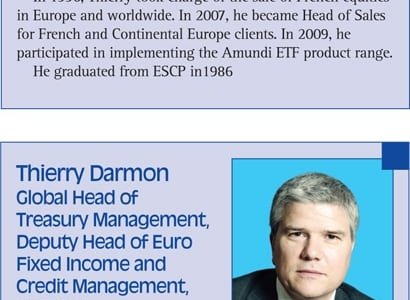by Thierry Ancona, Global Head of Corporate Clients, and Thierry Darmon, Global Head of Treasury Management, Deputy Head of Euro Fixed Income and Credit Management, Amundi
Since 2007, we have seen corporations accumulating ever-larger cash balances, keeping cash for a ‘rainy day’ or holding out for investment opportunities in the future as market confidence increases. In 2014, this situation is starting to change. In September 2014, mergers & acquisitions were at their highest level since the previous record in 2007, and as business confidence starts to improve in some countries, we are seeing investment in core business activities increasing.
According to the results of the ACT’s recent Corporate Cash and Liquid Investments Survey 2014, 72% of corporate treasurers say their firms have plans to use balance sheet cash, while 18% of respondents say their company has plans to run down cash aggressively. However, cash investment will remain an important priority: companies continue to hold significant levels of cash on their balance sheet, while 43% still expect to hold more cash than in the past given continuing uncertainties. While treasurers hold differing levels of cash, and the purpose of doing so may vary, cash investment remains a primary consideration.
The interest rate challenge
Over recent years, a major problem experienced by many treasurers is finding sufficient repositories of corporate cash that fulfil security and liquidity objectives. While companies that are embarking on capital-intensive projects and M&A may experience some relief, the challenges facing all corporate investors have been exacerbated by an extended period of low interest rates, particularly in euro. Following the ECB’s cuts in benchmark rates in June and September 2014, short-term rates are now trading far below zero. This has achieved the ECB’s desired effect of reducing the cost of EUR against the USD more significantly than previous cuts, and triggered a sale of EUR. However, for corporate treasurers, negative rates lead to the prospect of a further slump in investment returns beyond the negligible returns since the global financial crisis. This issue applies to all investors in short-term instruments, of course, but the consequences for money market funds have not been too dramatic so far, i.e., returns have not declined in relative terms more than any other instrument, and funds continue to offer the benefits that investors have always prized, namely secure, diversified assets with same-day access to liquidity.
The regulatory trigger
While the prevailing low interest rate environment impacts investors in all short-term instruments, there are specific developments taking place in the MMF sector, largely prompted by changing regulations. For example, in 2010, CESR and ESMA published guidelines to provide investors with a common definition of short-term MMFs (short-term MMFs) and money market funds (MMFs). This categorisation made it easier for investors to make more informed investment decisions, including deciding whether to invest in constant NAV (net asset value) or variable NAV funds. For example, short-term MMFs may have either a constant or variable NAV, while MMFs have a variable NAV. While many investors continue to be attracted to constant NAV, short-term MMFs, constant NAV funds now comprise less than 20% of €-denominated money market fund assets under management in Europe (€89bn of a total €480bn in assets), although corporate cash represent a sizeable proportion of this amount.
Sign up for free to read the full article
Register Login with LinkedInAlready have an account?
Login
Download our Free Treasury App for mobile and tablet to read articles – no log in required.
Download Version Download Version






























